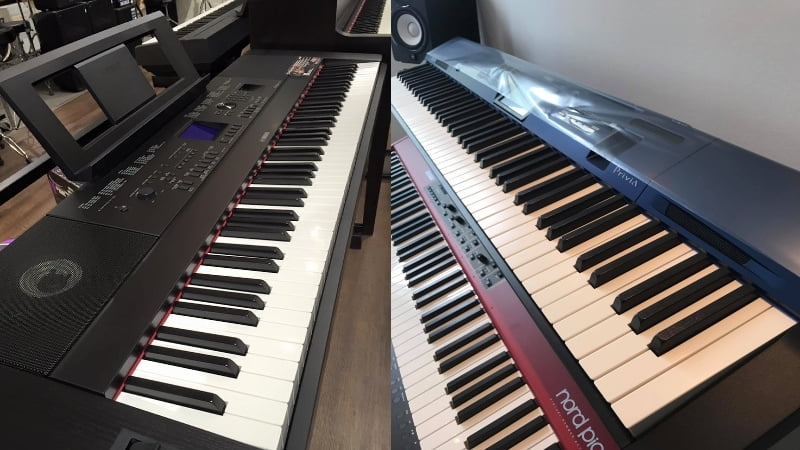Learn which piano offers more value for the money in this Yamaha DGX-660 vs Casio PX-560 review!
There are two pianos that have been living in my mind rent-free recently: the Yamaha DGX-660 and the Casio PX-560. These are two digital pianos that are fairly affordable but come with features that exceed their price range.
If you’re looking for a digital piano but don’t want to bust the bank, these are both great options.
But when you pit the Yamaha DGX-660 vs the Casio PX-560, which one wins?
Well, I did the comparison myself, and it was tight. These pianos were neck and neck in almost every category, but because of a better hammer action system and better tones, the Yamaha DGX-660 came out on top, even if by a very narrow margin.
Below, I’ll get into all the details of this comparison. I’ll discuss all the features, benefits, and drawbacks of each piano. So, when it comes time to choose a digital piano, you’ll know which one suits your needs the best.
Yamaha DGX-660 vs Casio PX-560: Comparison Chart


Last update on 2025-07-05 / Affiliate links / Images from Amazon Product Advertising API
Yamaha DGX-660 vs Casio PX-560: A Head to Head Comparison
The three categories that I sued to compare these pianos were the tone, feel, and the extra piano features. When judging digital pianos, these are three of the most important characteristics. And by the end of this comparison, the Yamaha DGX-660 came out on top with a score of 2-1.
It only won by one point because these two pianos are very close regarding their quality and value for the money. And even if the Casio PX-560 has better piano features, it wasn’t enough to push it ahead of the Yamaha DGX-660.
Tone
The winner: Yamaha DGX-660
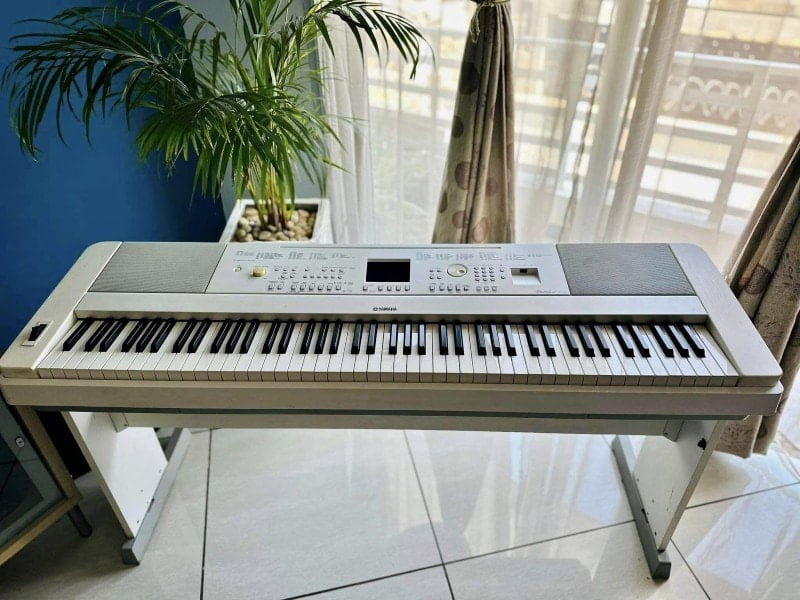
When it comes to tone, it’s really hard to beat Yamaha’s digital pianos. The brand maintains a reputation of having some of the best pianos and other voices for the price, which rings true with the DGX-660. The Casio PX-560 was able to provide some fairly realistic and high-quality tones.
However, when compared to the Yamaha DGX-660, it couldn’t win out, even if it had more voices in the sound library.
+Tone Generation
A great way to get into the specifics of a piano’s tone is by looking at the tone generator or the tone engine. The Yamaha DGX-660 features a very sophisticated tone engine, the Yamaha Pure CF Sound Engine, which is known for providing some of the most realistic tones in its price range.
On the flip side, the Casio uses multi-dimensional morphing AiR, which is also a good tone generator. Both of these tone engines rely on samples that you trigger whenever you press a key. But since the Yamaha featured higher-quality samples, it definitely had more realistic tones.
This is because the Pure CF Sound Engine relies on samples from real Yamaha CF Grand Pianos. Yamaha used the best possible equipment to record the samples so that you get the most true-to-life sound possible.
So, when I tested the pianos, the Yamaha clearly won in terms of tone quality. In fact, while the Casio surprised me with its realism, it couldn’t compare with the clarity and brightness of the Yamaha DGX-660. This is why I would recommend the Yamaha over the Casio, especially if you’re particular about the sound quality of your instrument.
+Sound Library
One of the things I really liked about these pianos was that they had loaded sound libraries. Both pianos have over 500 different voices to choose from, but the Casio PX-560 has a slight advantage as it comes with around 650 different voices.
The Yamaha only has a bit over 500 voices, which is far from limited, but definitely less than the Casio PX-560.
But even if the Casio had a much wider sound library, it wasn’t enough to put it over the Yamaha. This is because while the Yamaha has fewer tones, the difference in quality is very obvious. Just about any tone you select on the Yamaha will be more realistic and better quality than the Casio, which is why it still wins the point despite having fewer voices to choose from.
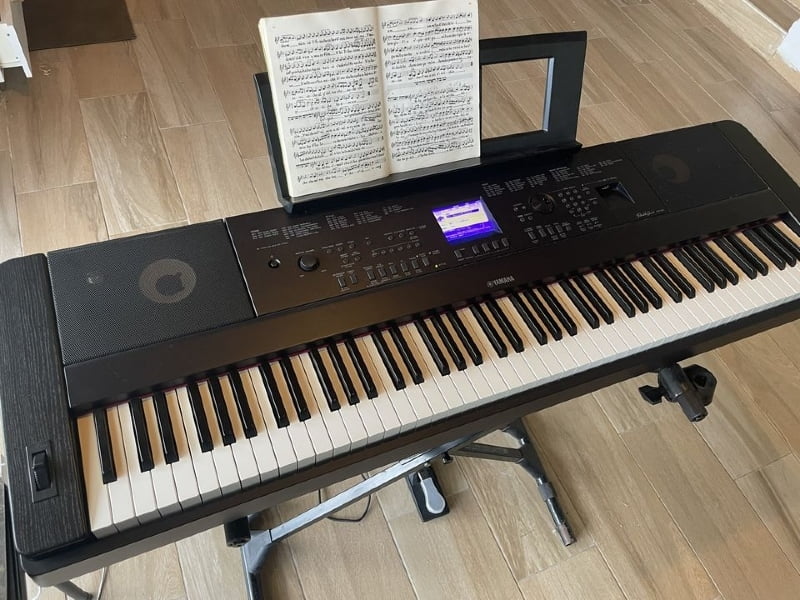
Feel
The winner: Yamaha DGX-660
The next comparison point I had was the feel. After all, you always want a digital piano to feel similar to an acoustic piano, especially if you want a serious instrument. And in this category, the Yamaha DGX-660 came out on top yet again since it has a more sophisticated hammer action system and textured keys. While the Casio also has textured keys and a similar hammer action system, I noticed that the Yamaha felt much more realistic.
+Hammer Action
The hammer action system on the Casio PX-560 is no joke. The tri-scaled hammer action features graded keys. This means that the lower bass keys have a bit more weight to them than the treble keys higher up on the piano. This is the same way an acoustic piano is set up, and it was really nice to see that Casio tried to capture these small details in their hammer action system.
And with the textured keys on the Casio PX-560, it was hard to beat it when comparing the feel.
However, as Yamaha usually does, it blew expectations out of the park with the keys on the Yamaha DGX-660. To start, it uses the Graded Hammer Standard or GHS system. This emulates the weight differences you feel on an acoustic piano, just like the PX-560, but I felt like the Yamaha did it a bit better.
On top of that, the texture on the Yamaha’s keys felt much closer to wood than on the Casio. While the Casio’s keys were definitely better than most other plastic keys in its price range, the Yamaha’s feels a bit more premium.
So, if you’re looking for a piano that offers a lot of realism when playing, the Yamaha DGX-660 is significantly better than the Casio., which is another reason why it won the overall comparison.
Piano Features
The winner: Casio PX-560
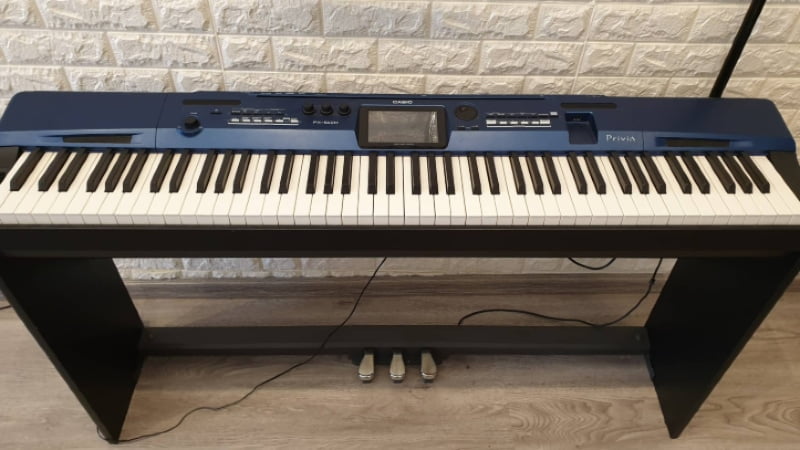
The last category I compared was the piano features. And in this category, the Casio PX-560 actually came out on top. Since it has a more varied set of effects and much better polyphony than the Yamaha DGX-660, it was the easy winner between the two. Keep reading to learn exactly why the Casio PX-560 has better piano features than the Yamaha DGX-660.
+Polyphony
Polyphony is a very important feature of digital pianos. This refers to the piano’s ability to play multiple notes simultaneously. And between these two models, the Casio PX-560 obviously comes out on top.
This is because it has 256-note polyphony, which is much better than that of the Casio, which is only 192-notes. While the difference may not seem that big, so you’ll never have to play 256 notes at the same time physically, it does come in handy when using the blending modes on the piano or if you want notes to ring out longer with the sustain pedal.
This isn’t such a big deal if you’re a beginner. However, if you’re a serious pianist that wants to put their own expressions and emotions in their playstyle, you need a piano with better polyphony.
+Effects
The next comparison point was the effects. And to my surprise, the Casio came out on top again. While the Yamaha DGX-660 has great reverb presets and effects, the Casio sports delay, reverb, chorus, DSP, and an EQ effect. That way, you truly get full control over your tone when you play the instrument.
Again, most beginners won’t need all these sophisticated effects. However, if you want to take full control of your tone and tweak it to your tastes, then the Casio PX-560 is a great pick.
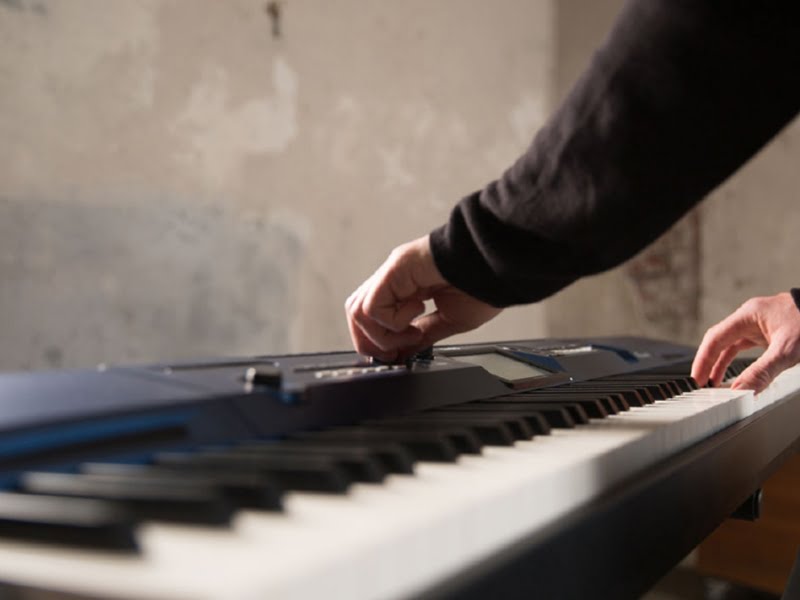
Yamaha DGX-660 vs Casio PX-560: The Similarities
While these pianos have a lot of differences, they share many similarities as well. To start, these pianos are great options for the price. They both offer great value for the money and come packed with features that are great for both beginners and advanced pianists.
For example, they both have multiple playing modes. That way, you have lots of room for experimentation, and you can adjust the piano’s sound depending on the type of music you’re playing.
Additionally, these are portable and very flexible pianos. So, you can bring them with you to gigs, jams, and piano lessons, which is very useful. And considering the price of these pianos, getting all these features without busting the bank is a great deal!
Quick Rundown of the Yamaha DGX-660
- The Pure CF Sound Engine faithfully reproduces the tone of a meticulously sampled and highly acclaimed Yamaha concert grand piano
- GHS weighted action is heavier in the low register and lighter in the high, just like an acoustic piano
- Score display puts music notation of MIDI songs on the screen, helping you play your favorites by following the bouncing ball
- The Piano room lets you choose from a variety of pianos and acoustic settings to create your own personal piano environment
- The 6 track recorder allows you to capture your performances and song ideas, then add additional layers to spice up your pieces
Last update on 2025-07-05 / Affiliate links / Images from Amazon Product Advertising API
Quick Rundown of the Casio PX-560
No products found.
Product Video
Related Articles to Yamaha Dgx 660
- Yamaha YDP-164 vs DGX-660: Why You Should Go for the DGX-660
- Yamaha DGX-660 vs Roland FP-90: Why the Roland FP-90 Is the Better Pick
- Yamaha DGX-530 vs 660: Why the DGX-660 Is the Better Pick
- Yamaha DGX-505 vs 660: Why the DGX-660 Is the Better Pick
- Yamaha DGX-660 vs DGX-640: A DGX Comparison
- Yamaha DGX-660 vs DGX-630: A DGX Comparison
- Yamaha DGX-620 vs 660: Finding the Best DGX Model
- Yamaha DGX-660 vs YDP-163: Which Is the Better Piano?
- Yamaha DGX-660 vs Roland Juno DS-88: Which Is the Better Piano?
- Yamaha DGX-660 vs Casio PX-360: Which Is the Better Piano?
- Yamaha DGX-660 vs YDP-144: Which Is the Better Yamaha Piano?
- Yamaha DGX-660 vs Korg Havian 30: Which Is the Better Digital Piano?
- Yamaha DGX-660 vs Casio CGP-700: Which Is the Better Pick?
- Yamaha DGX-660 vs YPG-535: Finding the Best Yamaha Digital Piano
- Yamaha DGX-660 vs P515: Is the P515 Worth the Extra Cost?
- Yamaha DGX-660 vs P-115: Which Yamaha Model Is Better?
- Yamaha DGX-660 vs 650: A DGX Comparison
- Korg XE-20 vs Yamaha DGX-660: Finding the Best Digital Piano
- Yamaha P45 Vs DGX-660: A Head-to-Head Comparison
- Yamaha DGX 670 Vs 660: The Distinct Difference In Details You Need To Know About
- Yamaha YDP-103 Vs DGX-660: Which Is The Better Yamaha Piano?
- Casio PX-770 Vs Yamaha DGX-660: Should You Get A Portable Or Console Digital Piano?
- Yamaha P71 vs DGX-660: Can the Amazon Exclusive Beat Out the Premium Model?
- Yamaha P125 vs DGX 660 Comparison: Can the P125 Hold Its Own Against the DGX 660?
References:
- Yamaha DGX-660: https://europe.yamaha.com/en/products/musical_instruments/pianos/portable_grand/dgx-660/specs.htmlv
- Casio PX-560: https://www.casio.com/intl/electronic-musical-instruments/product.PX-560MBE/
Lulacruza is an electronic folk duo operating at the junction of the hypermodern and the ancient. Our music weaves together hypnotic female singing, South American folk instruments and electronic processing, while channeling pulsating waves from the source of creation.
Lalucruza is also a community where you can connect with other music lovers to collaborate, exchange ideas and share knowledge. A platform for who wants to learns the basics of playing piano, guitar, drum masters’ technique, etc.. is the premise of our website.
